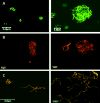Catalyzed reporter deposition-fluorescence in situ hybridization allows for enrichment-independent detection of microcolony-forming soil bacteria
- PMID: 16391135
- PMCID: PMC1352241
- DOI: 10.1128/AEM.72.1.918-922.2006
Catalyzed reporter deposition-fluorescence in situ hybridization allows for enrichment-independent detection of microcolony-forming soil bacteria
Abstract
Advances in the growth of hitherto unculturable soil bacteria have emphasized the requirement for rapid bacterial identification methods. Due to the slow-growing strategy of microcolony-forming soil bacteria, successful fluorescence in situ hybridization (FISH) requires an rRNA enrichment step for visualization. In this study, catalyzed reporter deposition (CARD)-FISH was employed as an alternative method to rRNA enhancement and was found to be superior to conventional FISH for the detection of microcolonies that are cultivated by using the soil substrate membrane system. CARD-FISH enabled real-time identification of oligophilic microcolony-forming soil bacteria without the requirement for enrichment on complex media and the associated shifts in community composition.
Figures




Similar articles
-
Microcolony cultivation on a soil substrate membrane system selects for previously uncultured soil bacteria.Appl Environ Microbiol. 2005 Dec;71(12):8714-20. doi: 10.1128/AEM.71.12.8714-8720.2005. Appl Environ Microbiol. 2005. PMID: 16332866 Free PMC article.
-
Cultivating previously uncultured soil bacteria using a soil substrate membrane system.Nat Protoc. 2008;3(8):1261-9. doi: 10.1038/nprot.2008.102. Nat Protoc. 2008. PMID: 18714294
-
Enumeration of methanotrophic bacteria in the cover soil of an aged municipal landfill.Microb Ecol. 2007 Nov;54(4):637-45. doi: 10.1007/s00248-007-9219-0. Epub 2007 Feb 24. Microb Ecol. 2007. PMID: 17323117
-
Single-cell identification in microbial communities by improved fluorescence in situ hybridization techniques.Nat Rev Microbiol. 2008 May;6(5):339-48. doi: 10.1038/nrmicro1888. Nat Rev Microbiol. 2008. PMID: 18414500 Review.
-
Fluorescence in situ hybridization (FISH) for direct visualization of microorganisms.J Microbiol Methods. 2000 Jul;41(2):85-112. doi: 10.1016/s0167-7012(00)00152-4. J Microbiol Methods. 2000. PMID: 10991623 Review.
Cited by
-
Microcolony cultivation on a soil substrate membrane system selects for previously uncultured soil bacteria.Appl Environ Microbiol. 2005 Dec;71(12):8714-20. doi: 10.1128/AEM.71.12.8714-8720.2005. Appl Environ Microbiol. 2005. PMID: 16332866 Free PMC article.
-
Development of an environmental functional gene microarray for soil microbial communities.Appl Environ Microbiol. 2010 Nov;76(21):7161-70. doi: 10.1128/AEM.03108-09. Epub 2010 Sep 17. Appl Environ Microbiol. 2010. PMID: 20851978 Free PMC article.
-
Cultivation of fastidious bacteria by viability staining and micromanipulation in a soil substrate membrane system.Appl Environ Microbiol. 2009 May;75(10):3352-4. doi: 10.1128/AEM.02407-08. Epub 2009 Mar 20. Appl Environ Microbiol. 2009. PMID: 19304839 Free PMC article.
-
CARD-FISH for environmental microorganisms: technical advancement and future applications.Microbes Environ. 2013;28(1):3-12. doi: 10.1264/jsme2.me12107. Epub 2012 Oct 31. Microbes Environ. 2013. PMID: 23124765 Free PMC article. Review.
-
Recent advances in the discovery and development of marine microbial natural products.Mar Drugs. 2013 Mar 8;11(3):700-17. doi: 10.3390/md11030700. Mar Drugs. 2013. PMID: 23528949 Free PMC article. Review.
References
-
- Behrens, S., C. Ruhland, J. Inacio, H. Huber, A. Fonseca, I. Spencer-Martins, B. Fuchs, and R. Amann. 2003. In situ accessability of small-subunit rRNA of members of the domains Bacteria, Archaea, and Eucarya to Cy3-labeled oligonucleotide probes. Appl. Environ. Microbiol. 69:1748-1758. - PMC - PubMed
-
- Binnerup, S., J. Bloem, B. Hansen, W. Wolters, M. Veninga, and M. Hansen. 2001. Ribosomal RNA content in microcolony forming soil bacteria measured by quantitative 16S rRNA hybridization and image analysis. FEMS Microbiol. Ecol. 37:231-237.
-
- Bouvier, T., and P. A. del Giorgio. 2003. Factors influencing the detection of bacterial cells using fluorescence in situ hybridization (FISH): a quantitative review of published reports. FEMS Microbiol. Ecol. 44:3-15. - PubMed
Publication types
MeSH terms
Substances
LinkOut - more resources
Full Text Sources
Other Literature Sources

